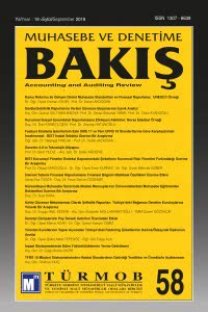KAMUDA İÇ DENETİM PERFORMANSININ ÖLÇÜMÜNDE DENGELİ BAŞARI GÖSTERGESİ (DBG) YAKLAŞIMININ DEĞERLENDİRİLMESİ
___
Aksoy,Tamer ve Kahyaoğlu,Sezer (2013), Measuring the Internal Audit Performance: Tips for Succesful Implementation in Turkey, American International Journal of Contemporary Research Vol. 3 No. 4Al-Twaijry, A.A.M., Brierley, J.A.,&Gwilliam, D.R.(2004), An Examination of the Relationship BetweenInternal and External Audit in the Saudi Arabian Corporate Sector, Managerial Auditing Journal, 19(7), 929–944.
Arena, M.,&Azzone, G.(2009), Identifying Organizational Drivers of Internal Audit Effectiveness.International Journal of Auditing, 13(1), 43–60.
Austin Chapter Research Committee. (2009), Performance Measures of Internal Functions: A Research Project.The Institute of Internal Auditors Research Foundation, Austin Chapter, USA, 11-15.
Australian Natıonal Audit Office (2000), Better Practice Prenciples for Performance Information, Performans Bilgisine Yönelik İyi Uygulama Prensipleri, S. Kaya ve S. Aral (çev.), Sayıştay, 34-40
Bota, C.,&Palfi, C.(2009),Measuring and Assessment of Internal Auditor’s Effectiveness, Annals of the University of Oradea, Economic Science Series, 18(3), 784
Caiden, N.(1998), “Public Sector Professionalism for Performance Measurement andEvaluation”, Public Budgeting and Finance, Summer, Vol. 18, No:2, 35-52.
Çıplak, V. ve Gürdal,T. (2014), Kamu Kesiminde İç Denetimin Etkinliği, 29. Türkiye Maliye Sempozumu, Antalya, 193-194.
Daft, R. L. (1997), Strategic Management, New Jersey: Prentice Hall International Inc., 13-14.
Delloite, (2010), ‘The changing role of internal audit’http://www.deloitte.com/view/en_BE/be/services/aers/in- ternalaudit.
Delloite, (2013), ‘İç Denetimin Yarattığı Katma Değer ve ölçümü’ https://www.tide.org.tr/uploads/17_Kongre_8_Ev- ren_Sezer.pdf.
Davies, M. (2009).Effective Working Relationships Between Audit Committees and Internal Audit—the Cornerstone of Corporate Governance in Local Authorities, a Welsh Perspective.Journal of Management and Go- vernance,13(1–2), 41–73.
De Brujin, H.(2002),“Performance Measurement in the Public Sector: Strategies to CopeWith the Risk of Performance Measurement”, The International Journal ofPublic Sector Management, Vol. 15, No.7, 581-583
Dittenhofer, M. (2001). Internal auditing effectiveness: An expansion of present methods. Manage-rial Auditing Journal, 16(8), 443–450.
DPT, (2006),Kamu İdareleri İçin Stratejik Planlama Kılavuzu, Ankara,
Epstein, P.(1988), Using Performance Measurement in Local Government, NationalCivic Leauge Press, New York, 3
Ernst&Young, (2007), ‘Global Internal Audit Survey, A current state analysis with insights intofuture trends and leading practices’, 5-20.
Ernst&Young, (2008), ‘Escalating the role of internal audit’, Ernst&Young Global Internal Audit Survey, accessible on-line at http://www.ey.com/global/content.nsf/International/AABS
Frigo, M. (2002). A Balanced Scorecard Framework for Internal AuditingDepartments. Florida: The Institute of Internal Auditors Research Foundation,Altamonte Springs, 50-54.
Haftacı, V. (2011), Muhasebe Denetimi, Umut Tepe Yayınları, 2’nci Baskı, Kocaeli, 28-65.
Institute of Internal Auditors (IIA) Research Foundation,(2006), A Global Summary of the Common Body of Knowledge(CBOK), Available at:http://www.theiia.org, 197-199
Institute of Internal Auditors (IIA),(2006),International Standards for the ProfessionalPractice of Internal Auditing. Florida: the IIA. Available at:http://www.theiia.org/guidance/standards-and-guidance/ippf/standards/
IIA,(2008). Global Audit Information Network(GAIN), Performance Monitoring/Quality Assurance Programs in the Internal Audit Activity, 1-9.
IIA.(2008),Performance Monitoring and QAIP, November .www.theiia.org/download.cfm?file=82004.
IIA.(2009).Knowledge Report: Measuring Internal Audit Performance.Retrieved fromhttp://www.theiia.org/GAIN
Kaplan, R.S and NORTON, D. (1997), Translating Strategy Into Action: TheBalanced Scorecard, HBS Press, Boston, MA, 61-62.
Korkmaz, U.,(2007),Kamuda İç Denetim I, Bütçe Dünyası, Cilt 2, Sayı 25.
Köseoğlu, M. A. (2005), Kitlerde Performans Ölçümü, Uzmanlik Tezi, Ankara: DPT., 20-30
Mihret, D.G.,&Yismaw, A.W.(2007).Internal audit effectiveness: an Ethiopian public sector case study. Managerial Auditing Journal, 22(5),470–484.
MSB (2016), MSB İç Denetim Birimi Stratejik Doküman Çalışması Raporu, Ankara, 12-15
Mizrahi, S, & Ness-Weisman, I. (2007). Evaluating the effectiveness of auditing in local municipalities using analytic hierarchy process (ahp): A general model and the Israeli example. International Journal of Auditing, 11, 187–210.
NAO,November 2005, Guidance on Independent Performance Assessment of the RegionalDevelopment Agencies, London.
NAO, (2006),Independent Performance Assessment: One NorthEast Development Agency,London.
Neely Andy, Andy- Gregory, Mike- Platts, Ken, (2005), “Performance Measurement System Design, A Literature Review and Research Agenda”, International Journal of Operations & Production Management, vol. 25, no. 12, 1228-1263.
Özkan, M.(2013), Y önetim Muhasebesi Açısından Sorumluluk Muhasebesi, Afyon Kocatepe Üniversitesi İİBF Dergisi, 155-182.
Parker, C.(2000), Performance Measurement, International Journal of Productivity andPerformance Management, Volume:49, Number: 2, 63-66.
Pop, A. & Bo a-Avram, C. (2009), ‘Criza economic global : activitatea de audit intern ar fiputut preveni aceast criz ?’, Revista de Audit Financiar Nr.7/2009, 14-22.
Prawitt, D.F., (2003), ‘Managing the internal audit function’, The Institute of Internal Auditors Research Foundation, accesibil on-line la www.theiia.org
PricewaterhouseCoopers, (2010), State of internal audit profession, accesibil online http://www.pwc.com/us/ en/internal-audit/ publications/2010-study-internal-auditprofession.jhtml
Rup ys, R.,&Boguslauskas, V.(2007), Measuring Performance of Internal Auditing: Empirical Evidence,Engineering Economics, 9–15.
Rup ys, R.(2007).Practical Aspects of the Integration of Internal Audit Activities Measures.Economics & Management, 108–113.
Sabuncuoğlu, Z. ve Tokol, T. (2013), İşletme, İstanbul: BETA Basım A.Ş.
Sayıştay,(2003),Sayıştay’ın Performans Ölçümüne İlişkin Önaraştırma Raporu, Ankara, 34-55
Schneider, A.(2010).Assessment of Internal Auditing by Audit Committees.Academy of Accounting & Financial Studies Journal, 14(2), 19–26.
Şimşek, Ahmet, (2013), Kalkınma Ajanslarının Performans Ölçümü, Uzmanlık Tezi, 39-50
Zain, M.M., Subramaniam, N.,&Stewart, J. (2006).Internal Auditors’ Assessment of their Contribution to Financial Statement Audits: The Relation with Audit Committee and Internal Audit Function Characteristics.In- ternational Journal of Auditing, 10(1), 1–18.
Ziegenfuss, D. (2000). Measuring Performance. Internal Auditor, 57 (1), 36-40.
- ISSN: 1307-6639
- Yayın Aralığı: Yılda 3 Sayı
- Başlangıç: 2000
- Yayıncı: TÜRMOB
Murat GÖRMEN, Mustafa SAVCI, Barış AYDEMİR
Fatih COŞKUN ERTAŞ, Ergin TEMEL
GELECEK DÖNEM NAKİT AKIŞI TAHMİNİNDE DÖNEM KÂRI VE NAKİT AKIŞI KARŞILAŞTIRMASI
TÜRKİYE’DE YERLİ MEVDUAT BANKALARINDA SERMAYE YETERLİLİĞİ VE KARLILIK İLİŞKİSİ
NİLGÜN ACAR BALAYLAR, Mehmet Ozan ÖZDMİR
Engin ERGÜDEN, Can Tansel KAYA, Begüm TANYER, Mete TÜRKYILMAZ
2014-2016 YILLARI ARASINDA BIST ŞİRKETLERİ İLE İLGİLİ DENETİM GÖRÜŞLERİ
Nalan AKDOĞAN, Elif Senem GÜDÜ, Ayşe IŞIK, İrem SEVİNDİK, Derya ŞAHİN, Gülşen ÖZKAN
İŞLETME KÖRLÜĞÜ VE ÇÖZÜM ÖNERİSİ OLARAK GÜVENİLİR DANIŞMAN “İÇ DENETİM”
Burcu ÖZGÜL, Banu Tarhan MENGİ
COSO KURUMSAL RİSK YÖNETİMİ ÇERÇEVESİ GÜNCELLEME PROJESİNİN GETİRDİĞİ YENİLİKLER
KAR YÖNETİMİNİN DÜZELTİLMİŞ JONES MODELİYLE ÖLÇÜMÜ: BIST’TE BİR UYGULAMA
